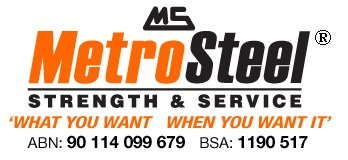One of the most current popular uses for stainless steel is in the construction of mesh security screening. Typically used for both window and door applications, they initially look like fly screens, but on closer inspection they appear far stronger and can’t be ripped or torn, either accidentally or on purpose. That said there are several different types or grades or steel used in the production of these screens but for the purposes of this article, we’re going to focus on two of the most popular- 316 and 304 grade.
So first of all what’s the difference?
304 grade steel is the most popular form of stainless steel by far. It’s low in carbon and higher in chromium nickel to help with resistance to oxidisation and corrosion and aid durability. It’s non magnetic and can be formed into a wide variety of shapes and structures – hence the popularity factor.
Conversely and in addition, 316 stainless steel contains an extra ingredient that 304 steel doesn’t and that’s molybdenum. Even though the molybdenum content is just 2%, it’s sufficient enough to give it a better anti-corrosive factor when exposed to a wide range of substances or solutions. One such substance is saline or rather- salt. This is why it’s often used in structural boat-building and the reason why it’s also more commonly known as marine grade steel!
So why does the grade of steel matter for security screens?
Under normal circumstances it probably wouldn’t as they both do the job of adding sufficient security and strength to any door or window opening. If anything the 304 grade steel is the cheaper option, so in many cases it might be advisable to opt for this type.
However, if you live in an area with a high salt content – eg. in seaside locations then you’d probably do better to opt for 316 marine grade steel. Salt is a highly corrosive substance and as such it can easily corrode many metals. In fact salt spray in coastal areas can become a real problem, even when your screens are made from standard 304 grade stainless steel. For this reason, the more expensive 316 grade steel, should always be the preferred choice. Like 304 grade steel, marine grade steel is easy to clean, weld, and finish, but unlike its counterpart, it provides greater protection against a wide variety of solutions.
The verdict
316 grade steel offers the better protection when exposed to salty elements, but it’s more expensive to manufacture and therefore to buy. However if you live 5kms or less from the coast then that’s what you should be opting for. On the flip side, if you’re one of the 20% who don’t live near the coast, then it mightn’t be the best financial option to purchase 316 when 304 will suffice.
Here at Metro Steel we’re always happy to dish out sound advice on any aspects of fabrication, so if you have a particular project in mind and need some help, then give us a call on 07 3204 1000. Alternatively, if you’re passing our Kabi Circuit fab shop, then pop in and talk to us directly.
 Talk to an Expert (07) 3204 1000
Talk to an Expert (07) 3204 1000 Working Hours - Mon – Fri 7:00 AM – 4:00 PM
Working Hours - Mon – Fri 7:00 AM – 4:00 PM